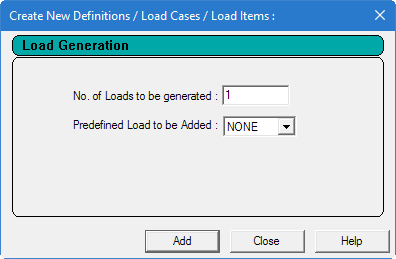Load Generation dialog
Used to create a primary load case using the data of a pre-defined vehicle.
Opens when the Load Generator tool is selected in the Load Generation group on the Loading ribbon tab.
Vehicles definitions are created using the Create New Moving Load Definitions dialog.
Refer to TR.32.12.1 Generation of Moving Loads for additional details.
| Setting | Description |
|---|---|
| No. of loads to be generated | The moving load is discretized into a number of distinct positions of the vehicle along the direction of movement. Each position represents a distinct load case whose loads are derived from the corresponding position of the vehicle on the structure. The number of such positions hence has to be communicated in the form of the number of load cases to be generated. For example, if a bridge is 200 ft long, the first axle to last axle distance of your design vehicle is 15 ft, and you want enough cases to be generated to account for the first axle entering the bridge up to and including the last axle leaving the bridge, that would account for a total distance of 230 ft. If you assume 2 ft increments, then the number of cases would be 230/2 + 1 = 116. |
| Predefined load to be added | With each generated load case, the program Used to include within that load case, other loads from a previous defined primary load case. Such a primary load case might be for example, the dead load case, which the user may defined as load case 1. So, if the user wishes to have each generated load case to consist of a) the selfweight and other dead loads of the structure b) loads resulting from the position occupied on the structure by the vehicle, then, he/she could specify load case 1 as the predefined load case to be added to each of the generated moving load cases. |

